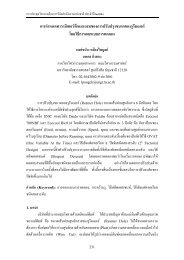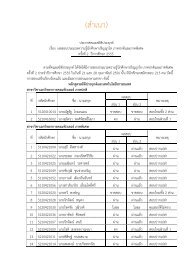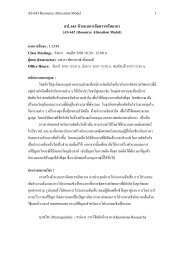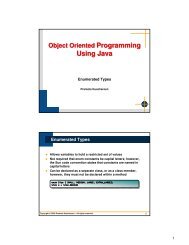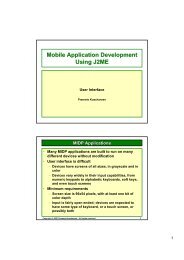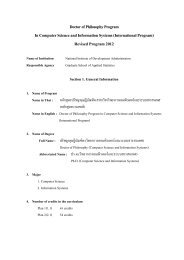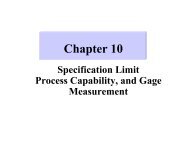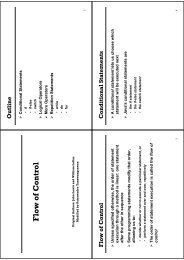ดาวน์โหลด All Proceeding - AS Nida
ดาวน์โหลด All Proceeding - AS Nida
ดาวน์โหลด All Proceeding - AS Nida
You also want an ePaper? Increase the reach of your titles
YUMPU automatically turns print PDFs into web optimized ePapers that Google loves.
However, there has been no report on the investigation of crossover and<br />
mutation operators and its interaction in machine layout problem.<br />
In manufacturing contexts, machine layout design (MLD) is<br />
the process of arranging machines into shop floor area which has effects<br />
on production cost and time [13]. The effective facility layout can help<br />
to reduce the production cost by 10-30% [14]. MLD problem is<br />
classified as Non-deterministic Polynomial-time hard (NP-hard)<br />
problem [15], which means that the amount of computation required to<br />
find solutions increases exponentially with problem size. Solving this<br />
kind of problem by full numerical methods especially for the large size<br />
can be computationally expensive. The approximation optimisation<br />
algorithms such as GA [16, 17], Simulated Annealing [18], Tabu Search<br />
[18] etc. have been applied to solve MLD problem but do not guarantee<br />
optimum solution [3].<br />
The categorisation of the characteristics of the layout<br />
problem depends on the criterion used [17] such as manufacturing<br />
systems (fixed layout, process layout, product layout and cellular<br />
layout), layout configurations (single row, multi-rows, loop layout, open<br />
field layout and multi-floor layout) and constrains (area, position and<br />
budget constraints). The machine orientation was classified as the<br />
positioning constraint is fixed (non-rotatable): horizon position –the<br />
long side is parallel to the x-axis, or vertical position –the long side is<br />
parallel to the y-axis [19, 20], or non-fix (rotatable) [21] as in figure 1.<br />
a) Horizontal b) Vertical C) rotatable<br />
Figure 1 Orientation of machine placement.<br />
The objectives of this paper are to i) describe the application<br />
of Genetic Algorithm (GA) for designing non-rotatable machine layout<br />
in a multiple-row environment aiming to minimise the total material<br />
handling distance and ii) investigate genetic operators (including sixteen<br />
crossover and eight mutation operators), that have an influence on the<br />
solution quality.<br />
The paper is organised as follows: section 2 describes the<br />
Genetic Algorithm process for solving MLD problem and its pseudocode<br />
followed by machine layout design in section 3, the experiment<br />
253<br />
results are presented in section 4. Finally, a conclusion is drawn in<br />
section 5.<br />
2. Genetic Algorithm for solving MLD problem<br />
The pseudo-code of the proposed GA for MLD shown in<br />
figure 2 can be described as follow: i) encode the problem to produce a<br />
list of gene using alphanumeric string. Each chromosome contains a<br />
number of genes, each representing machine number such as in figure 3.<br />
This means that the length of chromosome is equal to the total number<br />
of machines to be arranged. ii) prepare input data (Number of machines:<br />
Nm and dimension of machines: width (w) x length (l), number of parts:<br />
Np and its machine sequences: Si ) and identify parameters (Population<br />
size: Pop_size, Number of generation: Gmax, Probability of crossover: Pc, Probability of mutation: Pm, floor length (FL), floor width (FW)) and gap<br />
between machines (G). iii) randomly generate an initial population<br />
based on Pop_size. iv) apply crossover and mutation operators to<br />
generate new offspring based on Pc and Pm respectively. v) arrange<br />
machines row by row based on FL and FW. vi) evaluate the fitness<br />
function value. vii) select the best chromosome having the shortest<br />
material handling distance using the Elitist Selection. viii) choose<br />
chromosomes for next generation by using the Roulette Wheel<br />
Selection [22] and ix) stop the GA process according to the Gmax. When<br />
GA process is terminated, the best-so-far solution is concluded.<br />
Input problem dataset (N m , w, l, N p , S i )<br />
Parameter setting (Pop_size, G max, P c, P m, F L, F W, G)<br />
Randomly create initial population (Pop_size)<br />
Set i = 1 (first generation)<br />
While i ≤ G max do<br />
For j = 1 to cross do (cross = round ((P c x Pop_size)/2)))<br />
Crossover operation<br />
End loop for j<br />
For k = 1 to mute do (mute = round(P m x Pop_size))<br />
Mutation operation<br />
End loop for k<br />
Arrange machines row by row based on F L , F W and G<br />
Calculate material handling distance<br />
Elitist Selection<br />
Chromosome Selection using Roulette wheel method<br />
i = i + 1 End loop while<br />
Output the best solution<br />
Figure 2 Pseudo-code of GA for MLD problem.




